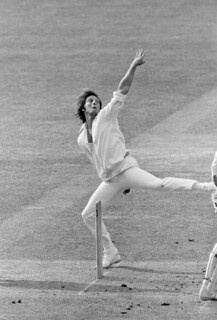Patrick Eagar made his career taking photographs of cricketers, though when he started out in London more than fifty years ago his subjects were mainly party people. In 1966, he took a picture with his Leica of someone he’d never heard of: Oskar Schindler. ‘It is not an exciting shot,’ he once said. ‘But it exists. It is just about the only photograph I have seen of Schindler.’
David Bailey, or Antonioni’s Blow-Up, was one model to follow, but Eagar went to Vietnam. When he returned he got a job at Which? magazine, where he says he ‘tested’ red wine. But photography was always the aim. In 1969 he photographed the images on his black and white television as Neil Armstrong and Buzz Aldrin walked on the moon. Motion in space is always slow motion, so a photographer looking on had more time to think about the action, such as it was. ‘Always been interested in astronomy and planets,’ says Eagar. ‘I devour the Nasa website to this day.’
Moonwalking and cricket both involve men in white, and both take time, but cricket is a game in which the action is typically of an instant. If you’ve taken the trouble to deconstruct action that takes place in slow motion, it might help inform the eye when taking pictures of something that takes no time at all. Batsmen who know how to play fast bowling are said to ‘have the time’ to play shots that others do not. Often, batsmen have eyesight that the rest of us do not. David Gower, in his twenties, could read the maker’s name on a mirror. But keen eyesight isn’t enough: to handle fast bowling you need experience of it. Photographers can use lenses to enhance their own eyesight, but as Eagar says, you’ve got to know what you’re hoping to take a photograph of, and that requires long experience of watching the action.
The photography Eagar saw in Sports Illustrated, the American weekly, in the 1970s was another factor. It published large, glossy, dramatic photographs of sportsmen, but not cricketers, which gave him his idea. In 1975, the Sunday Times and the Cricketer magazine published his pictures; many of them are reprinted in Christian Ryan’s new book on Eagar’s work during that year’s English cricket season, Feeling is the Thing that Happens in a 1000th of a Second (Riverrun, £20). These photographs made Eagar’s reputation. I was a boy at the time, and had a subscription to the Cricketer. I am amazed at how many of Eagar’s photographs I remember: most of the cricket I can recall from the summer of 1975 is in Eagar’s photographs.
In June 1975, Tony Greig, not yet England captain but soon to be given the post, was caught by the Australian wicket keeper, Rodney Marsh, at Headingley. It doesn’t look possible for Marsh to have made the catch; he is diving to his right, his body is horizontal and two feet off the ground. Eagar tells Ryan that he had two cameras aimed at Greig. In the second photograph of the same instant, only Marsh’s feet are in the picture; his dive to take the catch had taken the rest of his body out of the frame.
Eagar says he always hoped his pictures would be the illustrations to go with what he read in John Woodcock’s reports for the Times and what he heard in the radio commentary of John Arlott. On Midsummer’s Day in 1975, Clive Lloyd captained the West Indies team to victory at Lord’s in the first one-day world cup final. The game turned on Lloyd’s century, and Eagar took a picture of him smashing a ball through the offside. The pose of his body after executing the shot is exactly as the manuals say it ought to be: head straight, both feet grounded, the bat given its full swing. ‘Lloyd made the pitch and the stumps and the bowlers all seem much smaller than they were,’ Woodcock said in his report. There’s an Eagar photograph of Lloyd standing close to the boundary as the game is about to be won: he is a giant compared to the players behind him, out in the middle. In the distance, thousands of West Indians prepare to invade the pitch to celebrate. Lloyd is preparing to lift the cup, unaware that Eagar is behind him taking his picture – or not caring. The invisibility of the photographer is a central Eagar principle: ‘A photograph should be like a Cartier-Bresson moment, something you observe, not a reaction Annie Leibovitz style between the subject and the photographer. A lot of it is fashion I guess. Certainly these days, I find myself getting the subject to stare at the camera, because people expect it.’
One of Eagar’s most famous pictures is of the Australian fast bowler Jeff Thomson. He and his fellow opening bowler, Dennis Lillee, had savaged the English batsmen in the winter of 1974-75 so completely that some commentators had argued the rules of the game needed to be changed. Some saw the series as revenge for the ‘bodyline’ series in Australia in 1932-33, when Douglas Jardine used the Nottinghamshire fast bowler Harold Larwood to destroy Donald Bradman and the rest of the Australian batting order.
When the Australians beat England in the winter of 1974-75, none of them was yet thirty, yet in Eagar’s photographs the players all look older and much more manly than cricketers today. Eagar took a shot of Lillee and Thomson at Lord’s: male virility, camaraderie, individual touch are all there. Apart from the caps and sweaters, cricketers then wore more of what they wanted; Lillee’s trousers were more flared than anyone else’s, and the collars of Thomson’s shirts were enormous. Today’s cricketers look more like members of a chain-gang, every aspect of their dress a backdrop to the advertising they have printed on it.
Eagar devised a method of establishing the speed of Thomson and Lillee’s bowling. He set up two cameras next to each other and parallel to the wicket: one camera would take a picture of the ball in flight 0.045 seconds after the first. By measuring the distance the ball moved in that interval, Eagar thought he could extrapolate how long it would take the ball to travel from the bowler’s hand to the batsman. The experiment in the end didn’t matter; what Eagar got out of it is a photograph of Thomson like no other. What makes the picture, Eagar tells Ryan, is the position of Thomson’s bowling arm, which is behind his back, so that you can just see part of the ball in his hand between his legs. If that fraction of the ball wasn’t visible, this would be a non-photograph; Thomson would look as if he had lost his right arm. As it is, Eagar captured the instant when Thomson was just about to unleash a ball that might have been delivered at 95 mph. The bowler’s mouth is open; he looks to his left out of the corners of his eyes at his target. Other photographs may say more about the game of cricket, but no other picture better conveys the intent of the fast bowler who at the moment of delivery has eyes only for the batsman at the other end of the wicket. He’s in for the kill.
Send Letters To:
The Editor
London Review of Books,
28 Little Russell Street
London, WC1A 2HN
letters@lrb.co.uk
Please include name, address, and a telephone number.


